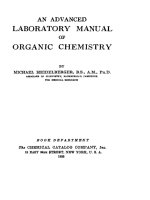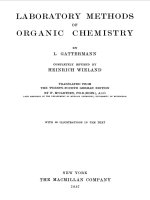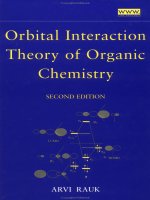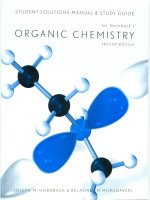Principles of organic chemistry 2nd ed r o c norman(1)
Bạn đang xem bản rút gọn của tài liệu. Xem và tải ngay bản đầy đủ của tài liệu tại đây (28.63 MB, 808 trang )
Principles of Organic Synthesis
www.pdfgrip.com
Principles of
Organic Synthesis
R. O. C. NORMAN
F.R.S.
Professor of Chemistry, University of York
SECOND EDITION
Springer-Science+Business Media, B.Y.
www.pdfgrip.com
©
1968, 1978 R. O. C. Nonnan
Originally published by Chapman and Hall in 1978.
ISBN 978-0-412-15520-8
ISBN 978-1-4899-3021-7 (eBook)
DOI 10.1007/978-1-4899-3021-7
All rights reserved. No part ofthis book may be reprinted, or reproduced
or utilized in any form or by any electronic, mechanicalor other means,
now known or herea[ter invented, including photocopying and recording,
or in any information storage and retrieval system, without permission
in writing from the Publisher.
Distributed in the U.S.A. by Ha/sted Press,
a Division 0/ lohn Wiley & Sons, Inc., New York
Library of Congress Cataloging in Publication Data
Norman, Richard Oswald Chandler.
Principles of Organic synthesis.
HA Halsted Press book."
IncIudes Index.
1. Chemistry, Organic-Synthesis. I. Title.
547'.2
78-784
QD262.N6 1978
www.pdfgrip.com
To R. P. B.
and W.A. W.
www.pdfgrip.com
Preface to the First Edition
The last thirty years have witnessed a profound increase in our understanding
of the ways in wh ich organic compounds react together-their mechanisms
of reaction. This has, on the one hand, become a large, discrete branch of organic
chemistry; but it has also, on the other, had a considerable impact on our
approach to devising methods for the synthesis of organic compounds. To the
student, reaction mechanism can have a two-fold appeal: it is, in its own right,
an intellectually stimulating subject in its rationalization and unification of
complex processes; and it also provides a relatively simple superstructure on
which the vast array of the facts of organic chemistry can be hung. In a paradoxical way, the amount to be usefully learned in a subject to which an array of
facts is being added daily remains, as our understanding grows, alm ost unchanged.
The purpose of this book is to show how an understanding of these mechanistic principles can usefully be applied in thinking ab out and planning the construction of organic compounds. It is designed for those who have had abrief
introduction to organic chemistry; an elementary knowledge of the nomenclature and structures of organic compounds is assumed. The text is divided into
two parts. In the first five Chapters, mechanism is set in its wider context of the
basic principles and concepts underlying chemical reactions: chemical thermodynamics, structural theory, theories of rates of reaction, mechanism itself, and
stereochemistry. In the remaining fourteen Chapters, these principles and
concepts are applied to the problems involved in putting together particular
types of bonds, groupings, and compounds. The account is not intended to be
exhaustive; for example, the vast body of evidence on which mechanisms are
based has been omitted, nor are experimental details included. The object has
been to convey a broad understanding rather than to produce a reference text.
I should like to acknowledge the help I have received from many of my former
colleagues at the Dyson Perrins Laboratory, Oxford, my present colleagues in
the University of York, and in particular Professor A. W. Johnson, F.R.S.,
who read the whole of the manuscript and made many helpful suggestions, and
two of my former pupils, Messrs. A. J. Hart-Davis and J. C. MacDougall, who
helped with the preparation of several Chapters.
R.O.C. NORMAN
vii
www.pdfgrip.com
Preface to the Second Edition
The ten years that have passed since this book was first published have served
to emphasize the value to the organic chemist of approaching problems in
synthesis with the aid of a thorough understanding of reaction mechanism. This
is apparent in the design both of new synthetic methods and of the multi-stage
synthesis of complex target molecules.
In this new edition, then, the basic Chapters which comprise Part I remain
essentially unchanged while the Chapters, in Part 11, which develop these basic
ideas and show their operation in practice, have been brought up to date. In
particular, there have been important advances in our understanding of the
course of pericyclic reactions-concerted processes which occur· within a cyclic
array of the participating atomic centres-and this has led to the complete redrafting of Chapter 9; valuable new methods which make use of reagents containing phosphorus, sulphur, or boron have been introduced (Chapter 15); and
the use of photochemical methods in synthesis has advanced to the stage where a
separate Chapter is justified. In addition, numerous new reagents have been
included, especially in the Chapters on oxidation and reduction. Finally, the
chance has been taken to transfer to S.1. units.
I am indebted to my colleagues Dr B. C. Gilbert and Dr J. M. Vernon for
their advice in producing this edition, and especially to my colleague Dr Peter
Hanson for his help in the preparation of the new material.
R.O. C.NORMAN
viii
www.pdfgrip.com
Contents
Preface to the First Edition
page vii
Preface to the Second Edition
PART I
I ntroduction to Part I
viii
3
1. Chemical Thermodynamics
1.1 Equilibrium
1.2 The First Law
1.3 The Second Law
1.4 Free energy
1.5 The effect of temperature Oll equilibrium
1.6 Bond energies
1.7 Entropy
1.8 Further applications of thermodynamic principles
17
2. Molecular Structure
2.1 Bonding
2.2 Quantum theory
2.3 Electronic structure of atoms
2.4 The covalent bond
2.5 Delocalization
2.6 A~plications of structuraI theory
28
28
32
34
42
45
3. Chemical Kinetics
3.1 Rates of reaction
3.2 The orders of reactions
3.3 Molecularity
3.4 The effect of tcmpcraturc Oll rcaction ratcs
3.5 Collision theory
3.6 Transition-statc thcOl'Y
3.7 Applications of kinctic priuciplcs
4. Mechanism
4.1 Unit processes in ürganic n.:actiolls
4.2 Typcs or rcaction
4.3 Addition
ix
www.pdfgrip.com
5
5
6
7
9
10
13
72
72
77
78
78
~: 1
83
96
\05
107
x
PRINCIPLES OF ORGANIC SYNTHESIS
4.4
4.5
4.6
4.7
4.8
4.9
Elimination
Substitution
Condensation
Rearrangement
Pericyclic reactions
Oxidation-reduction
116
125
138
139
141
142
5. Stereochemistry
5.1 Optical isomerism
5.2 The stereochemistry of cyclic compounds
5.3 Stereochemistry and reactivity
149
166
174
PART 11
Introduction to Part 11
199
6. Formation of Carbon-Carbon Bonds: Organometallic
Reagents
6.1
6.2
6.3
6.4
6.5
6.6
Principles
Organomagnesium compounds (Grignard reagents)
Organosodium compounds
Organolithium compounds
Organocopper compounds
Organocadmium compounds
202
204
215
215
219
220
6.7
Organozinc compounds
221
7. Formation of Aliphatic Carbon-Carbon Bonds:
Base- Catalyzed Condensations
7.1
7.2
7.3
7.4
7.5
7.6
7.7
Principles
Condensations of carbanions with aldehydes and ketones
Condensations of carbanions with esters
The alkylation of carbanions
Addition of carbanions to activated olefins
Condensations involving acetylides
Condensations involving cyanide
225
227
238
247
253
255
258
8. Formation of Aliphatic Carbon-Carbon Bonds:
Acid-Catalyzed Condensations
8.1
8.2
8.3
8.4
8.5
8.6
Principles
The self-condensation of olefins
Friedel-Crafts reactions
Prins reaction
Condensations of aldehydes and ketones
Mannich reaction
www.pdfgrip.com
265
266
267
269
270
275
CONTENTS
xi
9. Pericyclic Reactions
9.1 Principles
9.2 Cycloadditions
9.3 Electrocyclic reactions
9.4 Cheletropic reactions
9.5 Sigmatropic rearrangements
9.6 The ene-reaction and related reactions
284
288
303
307
311
317
10. Formation of Aliphatic Carbon-Nitrogen Bonds
10.1 Principles
10.2 Substitution by nuc1eophilic nitrogen at saturated carbon
10.3 Addition of nucleophilic nitrogen to unsaturated carbon
10.4 Substitution by nucleophilic nitrogen at unsaturated carbon
10.5 Reactions of electrophilic nitrogen
10.6 IX-Amino-acids, peptides, and proteins
322
324
330
339
343
348
11. Electrophilic Aromatic Substitution
11.1 The mechanism of substitution
11.2 Directive and rate-controlling factors
11.3 Formation of carbon-carbon bonds
11.4 Formation of carbon-nitrogen bonds
11.5 Formation of carbon-sulphur bonds
11.6 Formation of carbon-halogen bonds
11.7 Other reactions
11.8 The preparation of derivatives with specific orientations
367
370
383
400
406
408
412
417
12. Nucleophilic Aromatic Substitution
12.1 Principles
12.2 Displacement of hydride ion
12.3 Displacement of other anions
12.4 Substitution via benzynes
12.5 Bucherer reaction
422
425
426
430
433
13. Aromatic Diazonium Salts
13.1 The formation of diazonium ions
13.2 The reactions of diazonium ions
13.3 Reactions in which nitrogen is eliminated
13.4 Reactions in wh ich nitrogen is retained
13.5 The synthetic value of diazo-coupling
435
436
437
444
449
14. Molecular Rearrangements
14.1 Types of rearrangement
14.2 Rearrangement to electron-deficient carhon
454
454
www.pdfgrip.com
xii
PRINCIPLES OF ORGANIC SYNTH ESI S
14.3 Rearrangement to electron-deficient nitrogen
14.4 Rearrangement to electron-deficient oxygen
14.5 Rearrangement to electron-rich carbon
14.6 Aromatic rearrangements
467
471
473
476
15. Reagents Containing Phosphorus. Sulphur. or Boron
15.1 Introduction
15.2 Phosphorus-containing reagents
15.3 Sulphur-containing reagents
15.4 Boron-containing reagents
484
485
489
498
16. Photochemical Reactions
16.1 Principles
16.2 Photoreduction
16.3 Photo-addition
16.4 Photorearrangement
16.5 Photo-oxidation
16.6 Photochemical aromatic substitution
16.7 Photochemical fragmentation
507
511
512
516
522
524
526
17. Free-Radical Reactions
17.1 Principles
17.2 Formation of carbon-halogen bonds
17.3 Formation of carbon-carbon bonds
17.4 Formation of carbon-nitrogen bonds
17.5 Formation of carbon-oxygen bonds
17.6 Formation of bonds to other elements
534
541
548
557
562
564
18. Oxidation
18.1 Introduction
18.2 Hydrocarbons
18.3 Systems containing oxygen
18.4 Systems containing nitrogen
18.5 Systems containing sulphur
18.6 Systems containing phosp~orus
18.7 Systems containing iodine
567
568
587
600
604
605
606
19. Reduction
19.1 Introduction
19.2 Hydrocarbons
19.3 Hydrogenolysis
19.4 Aldehydes and ketones
19.5 Epoxides
609
611
625
630
637
www.pdfgrip.com
xiii
CONTENTS
19.6 Acids and their derivatives
19.7 Systems containing nitrogen
19.8 Systems containing sulphur
639
647
653
20. The Synthesis of Heterocyclic Compounds
20.1
20.2
20.3
20.4
20.5
20.6
Introduction
Five-membered rings containing one hetero-atom
Five-membered rings containing two hetero-atoms
Six-membered rings containing one hetero-atom
Six-membered rings containing two hetero-atoms
Six-membered rings containing three hetero-atoms
657
660
670
676
692
700
21. The Synthesis of some Naturally Occurring Compounds
21.1 Vitamin A
21.2 ß-Carotene
21.3 Cholesterol
21.4 Oestrone
21.5 Epiandrosterone
21.6 Quinine
21.7 Reserpine
21.8 Adenosine triphosphate
21.9 Penicillin
21.10 Chlorophyll
21.11 Prostaglandins E 2 and F 2«
710
715
717
723
726
729
733
740
744
748
758
Index
771
www.pdfgrip.com
700
Part I
www.pdfgrip.com
I ntroduction to Part I
The five Chapters which comprise Part I are concerned with the principles wh ich
govern organic reactions.
The first Chapter examines the implications of the laws of thermodynamics.
Reactions can "go"-that is, have equilibrium constants greater than unityonly if the products have a lower free-energy conte nt than the reactants. The
free energy of a species is related to its enthalpy, wh ich is determined essentially
by the strengths of the bonds it contains, and to its entropy, ~hich is a measure
of its degree of disorder; a low free energy corresponds to a system's having
strong bonding forces and a high degree of disorder. From thermodynamic
considerations there follows, for example, an understanding ofwhy it is possible
to reduce acetylene to ethylene at room temperature whereas cthylene is successfully dchydrogenated to give acetylene at a temperature of about 1,OOO°C.
The second Chapter considers the current theories of bonding in organic
moleeules and relates these to the strengths of the bonds in typical chemical
groupings. Thus, the different chemical properties of benzene and ethylene are
then seen to be related to the very considerable stabilization energy of the
benzene ring. Other properties of organic compounds which are of importance
in synthesis, such as the acidities of C-H bonds in various environments, also
follow from structural theory.
That there should be a negative free-energy change is in practice a necessary
but not a sufficient condition for a reactioll to occur, for the rate at which it
takes place may be negligible. Thermodynamic considerations alone indicate
that hydrocarbons should not coexist with air, for the free-energy change
involved in their oxidation to carbon dioxide and water is significantly negative;
in practice, however, their rates of combustion at ordinary temperatures are
negligible. The third Chapter sets out the theories of reaction kinetics and the
effects of temperature on rate, and then introduces correlations of the rates of
specific types of reaction with structure.
The planning of syntheses is helped considerably by an understanding of the
mechanisms by which reactions occur. It must be emphasized that mechanisms
are theories and not Jacts of the subject; they have been deduced from experimental observations and in some instances they transpire to be incorrect or at
least in need of refinement; one should say, rather, 'the mechanism is thought
to be,' than 'the mechanism is.' Nonetheless, the current mechanistic theories,
which are surveyed in the fourth Chapter, not only provide an intellectuaUy
3
www.pdfgrip.com
4
PRINCIPLES OF ORGANIC SYNTHESIS
satisfying and unifying picture of the complexity of reactions, but also enable
predictions to be made, with increasing assurance as the degree of rationalization
of the subject increases, of the effects wh ich structural modifications will have
on the course of areaction.
Stereochemistry-the study of the spatial relationships of atoms and bondswould in the past have been a natural adjunct ofthe study ofmolecular structure.
It is now as important to considerations of chemical dynamics as to those of
chemical statics, and follows naturally, in the last Chapter, the study of kinetics
and mechanism. Indeed, it is closely intertwined with mechanism; many naturally
occurring compounds have a complex and highly specific stereochemistry, and
it has only been through an understanding of the stereoelectronic principles of
reactions that their syntheses have been successfully planned and executed.
www.pdfgrip.com
1. Chemical Thermodynamics
1.1 Equilibrium
All chemical reactions are in principle reversible: reactants and products eventually reach equilibrium. In some cases, such as the esterification of an acid by an
alcohol,
the equilibrium situation is quite closely balanced between reactants and
products, whereas in other cases the equilibrium constant is either very high or
very low, so that the reaction goes essentially to completion in one direction or
the other (given the appropriate conditions). From the point of view of devising
an organic synthesis it is necessary to know whether the position of equilibrium
will favour the desired product. The factors which determine the equilibrium
constant of areaction and its variation with changes in conditions follow from
two of the most firmly established naturallaws: the First and Second Laws of
Thermodynamics.
1.2 The First Law
The First Law of Thermodynamics is commonly expressed as the Law of
Conservation of Energy: energy can be neither created nor destroyed. Consider
a system into which an amount of heat q is introduced. The absorption of this
heat may bring about both an increase in the energy of the system (manifested,
for example, by a rise in the temperature) and also the performance of work, W,
by the system (as, for example, the pushing back of a piston by a heated gas *).
Then it follows from the First Law that, for a change from state A to state B,
q
=
t1E
+W
where t1E is the change in energy of the system. It is convenient to define a
function E as the internal energy of the system; t1E is then equal to E B - E A ,
where EA and E B are the energies of the initial and final states.
If the process is carried out at constant volume, no mechanical work is done
by the system and q = .JE. On the other hand, if the process is carried out at
*There are other forms of work, such as electrical work, but we shall not be concemed
with these.
5
www.pdfgrip.com
6
PRINCIPLES OF ORGANIC SYNTHESIS
constant pressure thc work done is PtJ V, wherc tJ V is the change in volumc
of the system., Then
q = JE + PtJ V
= EB
= (EB
-
EA
+ PVB -
+ PVB)
-
(EA
PVA
+ PVA )
Since E, P, and V are functions of the state of thc system, (E + PV) is also
sucha function. This property is termed the heat content or enthalpy, H, and
proves to be important in chemical systems where we are usually concerned
with changes taking place at constallt (e.g., atmospheric) pressure.
1.3 The Second Law
If a box-full of red balls and a box-full of blue balls are poured into a container and shaken up, we shall expect to find when the balls are poured back
into the two boxes that each box contains approximately eqmil numbers of red
and blue balls. On the other hand, if we start with boxes containing mixtures
of the balls we shall not expect to find, after the mixing process, that all the red
balls end in one box and the blue balls in the other. Again, if a poker is made
red-hot at one end, the heat gradually diffuses along the poker until eventually
its temperature is uniform along its whole length. We do not, however, observe
the reverse of this process: a poker at ambient temperature ncver becomes
hotter at one end and colder at the other, even though this would not necessarily
contravene the First Law.
Observations ofthis type Ied to the enunciation oftheSecond Law ofThermodynamics, the classical form of which is that 'heat does not fiow spontaneously
from a 90lder to a hotter body.' The relevance of this Law to the example of
the poker is obvious, but its applicability to the problem of mixing balls of
different colours is not immediately apparent. It becomes so, however, when it
is realized that the Second Law is concerned with probabilities: it is extremely
improbable that a mixture of red and blue balls will, by a shuffling process, end
in the ordered condition of separate groups of red balls and blue balls. Given
only six red and six blue balls, if is 200 times as probable that the first six balls
poured from the mixing container into one box will consist of three red and three
blue than that they will be all red or all blue. Moreover, the ratio of the number
of ways in which a system can be arranged in a 'random' manner to
those corresponding to a particular 'ordered' arrangement increases rapidly
with the number of species contained in the system, so that in the case of chemical
molecules, which in any particular system under observation are numbered in
many powers of ten, the likelihood of an 'ordered' system emerging spontaneously from a 'disordered' one is negligible. We should not expect that the
random collisions between the molecules in the poker would result in all the
www.pdfgrip.com
7
CHEMICAL THERMODYNAMICS
faster moving (i.e., botter) moleeules accumulating at one end of the poker and
all the slower moving (i.e., colder) molecules at the other, but, given this ordered
situation (by beating tbe poker at one end), we sbould expect the faster and
slower moving moleeules to attain a random arrangement, as a result of molecular movements and collisions, corresponding to a uniform temperature along
tbe poker.
Tbere is tbus a tendency for ordered systems to become disordered. It is
convenient to have a measure of the degree of disorder of a system, and this is
defined as its entropy, S, where S = k In W, W being the number of ways in
which the system may be arranged and k being Boltzmann's constant. In the
two irreversible processes described above (the mixing of differently coloured
balls and tbe achievement of uniform temperature in the poker) there is an
increase in the entropy of tbe system, and an alternative formulation of the
Second Law of Thermodynamics is that 'the entropy of an isolated system tends
to increase.'
1.4 Free Energy
We assumed, in considering the mixing of red and blue balls, that no forces
were operative. Suppose now that the red balls exert strong attractive forces on
balls of their own kind and repulsive forces on blue balls. There will then be a
tendency for the red balls to stay togetber so as to decrease tbe potential energy
of the system, and tbis will oppose the tendency for the entropy of the system to
increase. It transpires, from thermodynamical arguments, that the resulting
compromise of these opposed trends is determined, for a system at constant
pressure and temperature, by the value of the function (H - TS): this tends to
decrease, and the compromise situation (i.e., equilibrium) corresponds to its
minimum value. It is convenient to define a new function, G, the Gibbs free
energy, as G = H - TS. A process will occur spontaneously if, as a result, G
decreases. It will continue until G reaches aminimum, and this point corresponds
to the equilibrium situation; forward and reverse reactions continue, but at
equal rates; that is, the equilibrium is a dynamic one. Consider areaction occurring at temperature Tin the gas phase. Since
G
=
H - TS
=
E
+ PV -
TS,
dG=dE+PdV+ VdP-TdS
For an equilibrium situation it can be shown that TdS = dq, and since (from
1·2) dq = dE + PdV
dG = VdP
Since, for 1 mole of a perfect gas at a constant temperature, PV = RT, i.e.,
www.pdfgrip.com
8
v=
PRINCIPLES OF ORGANIC SYNTHESIS
RTfP, integration gives,
I
1
[Gn = f VdP = f(RT/P)dP = [RT In pn
°
°
for a change in the system between the two states for which G = GO and GI,
respectively,
It is convenient to take GO as the free energy of the gas at temperature Tin its
standard state (i.e., for 1 mole at 1 atmosphere pressure). Then GI - GO = RT
In Pt.
Consider the equilibrium,
A+B~C+D
The free-energy change in the reaction is the sum of the free energies of the
products minus the sum of the free energies of the reactants, i.e., LlG = G(C)
+ G(D) - G(A) - G(B). Thus,
Now, if the set of pressures, Pt> are the equilibrium pressures in the gas mixture,
ther., since at equilibrium G must be a minimum with respect to any displacement of the system, LlG I = 0, and it follows that
Since the GO values are dependent only on temperature,
where K p is also dependent only on temperature.
For areaction in solution it may readily be shown that
where c' is the concentration of the ith reactant at equilibrium. (Strict1y, c'
should be replaced by the activity, a i.)
Thus, equilibrium constants are related to the standard free energies of the
reactants and products, and a knowledge of these enables us to predict whether
a given set of reactants is likely to yield a desired set of products. If LlGo is
www.pdfgrip.com
9
CHEMICAL THERMODYNAMICS
negative, the equilibrium constant (greater than I) is favourable to the formation
of the products, whereas if LlGo is positive it is correspondingly unfavourable. *
Standard free energies have been measured for a large number of organic
and inorganic compounds. For example, those of ethylene, ethane, and hydrogen
in the gaseous state at 25°C are 68, -33, and 0 kJ mol-i, respectively.
(By convention, the most stable allotrope of an element in its standard state
at 25°C is assigned a free-energy value of zero. The scale of free energies is
therefore an arbitrary one, but this is immaterial since we are always concerned
with difJerences in free energies.) Therefore the reaction
has LI GO = + 101 kJ mol- 1, so that we cannot obtain ethylene from ethane
in significant amount under these conditions although we may expect to
obtain ethane from ethylene. Notice, however, that even though a free-energy
change may be favourable, the rate of formation of the product may be too slow
for the reaction to be practicable, or the reaction may take a different course
(e.g., ethylene might react with two molecules of hydrogen to give two molecules
of methane, which is also a thermodynamically favourable process). Fulfilment
of the thermodynamic criterion is therefore a necessary but not a sulfident
condition for areaction to occur. The factors which control rates of reaction
and the pathways which reactions take are discussed in subsequent chapters.
Thermodynamic data also give no information about the reasons why the
free energies of compounds have particular values. Ethylene, for example, has
a positive standard free energy offormation, whereas that for ethane is negative;
that is, ethylene is unstable with respect to carbon and hydrogen and ethane is
stable. These are empiricalfacts; the reasons underlying thern lie in the realm
of theory, namely, the theory of chemical structure and bonding, which is
discussed in the next chapter.
1.5 The Effect of Temperature on Equilibrium
Since RT In Kp = -LlGo = - LJHo
+ TLJSo,
d In KpjdT
=
LJHOjRT 2
This expression, the van't Hoff isochore, shows how the equilibrium constant
va ries with temperature.
The isochore not only enables JHo to be evaluated by measurement of the
equilibrium constant at aseries of temperatures, but also indicates that the
equilibrium constant in an exothcrmic reaction (negative JHO) decreases with
*An 'uphiU' reaction may, however, occur if the product is removed from equilibrium by,
for example, precipitation or involvement in a subsequent reaction.
www.pdfgrip.com
10
PRINCIPLES OF ORGANIC SYNTHESIS
rise in temperature whereas that of an endothermic reaction (positive LJHO)
increases. In effect, the isochore is a mathematical formulation ofthe application
of Le Chatelier's principle to temperature changes.
An example of the application of the equation occurs in the commercial
production of Buna S rubber, a synthetic rubber obtained by copolymerizing
styrene and butadiene. These components are made from benzene and ethylene,
and from I-butene, respectively:
C6HS--C2HS
~
C6Hs-CH=CH2
Styrene
+ H2
CH3-CH2-CH==CH2 .= CH2=CH-CH=CH2
Butadiene
+ H2
The first reaction is exothermic and the others endothermic. For the formation of ethylbenzene, In K p is calculated from thermodynamic data to be
about + 5 at 200°C and zero at 800°C, so that the yield of ethylbenzene is
increased by operating at as low a temperature as possible, consistent with the
occurrence of the reaction at a practicable rate. Conversely, the yields of
styrene and butadiene are improved by carrying out the reactions at the highest
temperatures compatible with the non-oecurrenee of side-reactions.
1.6 Bond Energies
Most reactions result in the absorption or liberation of heat, e.g.,
CH ..(g) + 2 02(g) ->- CO 2(g) + 2 H 2 0(/)
Heats of reactions may be employed in an additive manner. For example,
the heats of the following three reaetions have been measured (the first two
bya spectroscopic and the third by a calorimetric procedure):
(1) H 2 -+2 H
LJHO
=
435 kJ
(2) O 2 -+20
LJHo =
494 kJ
(3) H 2
+ t O 2 -+ H 2 0
LJHo = -242 kJ
It follows that, rür the readion
(4) 2 H
+0
-)- IIzO
LJH(4) = LJH(3) - LJH(l) -tLJH(2) = -924 kJ
for if JH(4) had any other valuc, it would be possible 10 earry out the four
reactions in such a sequencc that thc starting materials could bc rccovcrcd in
thcir original state and energy could be gained at the same time, contrary to the
First Law of Thermodynamics.
www.pdfgrip.com
11
CH EMICAL TH ERMODYNAMICS
Measurement of the heats of certain reactions enables the heats of others to
be calculated. Moreover, such calculations are facilitated by constructing a
table of bond energies from the observed data, taking as the reference point the
heat of formation of molecules from their constituent atoms. For instance,
from the heat of combustion of methane quoted above together with the heats
of formation of carbon dioxide and water, the heat of the reaction,
CH4(g) ~ C(g)
+ 4H(g)
is caIculated to be 1655 kJ, '" and since four C- H bonds are broken in the
process, the bond energy of the C- H bond is defined as one-quarter of this,
414 kJ. The 0- H bond energy is one-half the heat of formation of water,
i.e., 462 kJ. To a elose approximation, bond energies are constant for a particular bond in different structural environments, so that, given the bond
energies 414,357, and 462 kJ for C-H, C-O, and O-H bonds respectively,
the total bond energy of methanol, which contains three C-H, one C-O,
and one 0- H bond, is caIculated to be 2061 kJ, in fair agreement with the
experimental value (1985 kJ) derived from the heat of combustion of methanol.
Bond energies for a ntlmber of commonly occurring structural units are given
in Table 1.1.
Table 1.1
H-H
H-F
H-Cl
H-Br
H-I
F-F
Cl-Cl
Br-Br
I-I
Bond energies (kJ mol- 1) at 25°C
C-C
C=C
C=C
N-N
N=N
N=N
C-N
C=N
C=N
435
560
428
364
297
150
238
188
150
al n formaldehyde.
bIn other aldehydes.
347
610
836
163
418
940
305
614
890
C-O
c=oa
C=Ob
c=oc
H-C
H-N
H-O
0-0
S-S
357
694
736
748
414
389
462
155
251
CIn ketones.
*This is the sum of the heats of the following five reactions:
+
CH4(g) 2 02(g) ~ C02(g)
CO 2(g) ~ C(s) + 02(g)
2 H20(1) ~ 2 H 2(g) + Oz(g)
2 H2(g) ~ 4 H(g)
C(s)~ C(g)
+2
H20
The heat of the last reaction, the atomization of carbon, is necessary because the heat of
formation of carbon dioxide is measured for solid carbon whereas bond-energy data refer
to atoms, i.e., 'gaseous' carbon. It has been difficult to measure the heat of atomization of
carbon, but the value now generally accepted is 718 kJ mol- 1 •
www.pdfgrip.com
12
PRINCIPLES OF ORGANIC SYNTHESIS
Bond energies quoted above are average bond energies, and it is often more
useful to know the energy required to break a particular bond in a compound,
i.e., the bond dissociation energy. Although the O-H bond energy is, by definition, one-half the heat of formation of water, in fact a greater quantity of energy
is required to break the first O-H bond in water (H 2 0 -+ HO + H; ~H =
491 kJ) than thc second (HO -+ 0 + H; AH =433 kJ). The bond dissociation
energy is therefore greater than the bond energy, and this is commonly the
case, except for diatomic molecules for which the values are necessarily identica!. Some typical bond dissociation energies are set out in Table 1.2.
Table 1.2 Bond dissociation energies (kJ mol-I)
H-CH 3
H-CH 2 CH 3
H-CH(CH 3 h
H-C(CH 3 h
H-CH 2 Ph
426
401
385
372
322
H-OH
H-NH 2
CH 3 -OH
CH 3 -NH 2
CH 3 -CH 3
491
426
376
334
347
CH 3 -F
CH 3 -Cl
CH 3 -Br
CH 3 - !
CH 3 -N0 2
447
339
280
226
238
The premise on which the use of Table 1.1 is based, that bond energies are
constant for a particular bond in different environments, requires eloser examination. If it were strictly true, for example, the heats of combustion of the three
isomeric pentanes, each of which cOlltains four C-C and twelve C-H bonds,
would be the same. In fact, they are different: n-pentane, 3533; isopentane,
3525; neopentane, 3513 kJ mol- 1 . Nevertheless, the percentage differences
are so small in this and many similar cases that bond-energy data are of considerable use. However, there are certain structural environments in wh ich
appreciable differences between observed and predicted bond energies occur.
One example, in Table 1.1, concerns the carbonyl group, whose bond energy
is nearly 10% greater in ketones than in formaldehyde, and is greater still
(804 kJ) in carbon dioxide.
A more general deviation occurs with conjugated compounds, that is, compounds possessing alternating single and double bonds. For example, consider
the following hydrogenations :
+ 2 H 2 ->- CH 3 CH 2 CH 2 CH 3
CH 2 =CH-CH 2 -CH=CH 2 + 2 H 2 ->-CH 3 CH 2 CH 2 CH 2 CH,
CH 2 =CH-CH=CH 2
~HO =
~Ho
-238·7 kJ
= -254·2 kJ
If bond energies were strictly additive, the heats of hydrogenation in the above
reactions should be the same, since in each, two C=C double bonds are converted into single bonds, two H-H bonds are broken, and four C-H bonds
are formed. The lower value for butadiene shows that this is a more stable
compound than predicted by examination of 1,4-pentadiene, and this proves
to be so for other conjugated systems. We shall refer to the difference between
www.pdfgrip.com
13
CHEMICAL THERMODYNAMICS
predicted and observed values of heats of hydrogenation as the stabi/ization
energy.
The attachment of alkyl groups to olefinic carbon also leads to the introduction of stabilization energy. For example, whereas the heat of hydrogenation
of ethylene is 137 kJ mol- 1 , that of propylene (CH 3 CH=CH 2 ; one alkyl group)
is 126 kJ mol- l and that of trans-2-butene (CH 3 CH=CHCH 3 ; two alkyl
groups) is 115 kJ mol-I; i.e. the stabilization energies are 11 and 22 kJ mol-i,
respectively.
For those cyclic, conjugated compounds which are aromatic (2.6b) heats of
hydrogenation are in many cases very considerably less than the predicted
values. The stabilization energies of benzene, naphthalene, and anthracene are
respectively, 150,255, and 349 kJ mol- l .
An understanding of the origin of stabilization energies follows from current
theories of molecular structure (Chapter 2). It is here necessary to emphasize
that bond-energy data must be used with care but that nevertheless, conjugated
and aromatic systems excepted, they provide a useful working basis for predictive purposes.
1.7 Entropy
In the problem of the mixing of red and blue balls, the entropy of the ordered
system (red and blue balls each in their initial containers) is zero since S =
k In Wand there is only one way in which the system can be arranged (W = 1).
If, however, the red and blue balls were atoms or molecules the entropy of the
initial (unmixed) system would not be zero, except for perfect crystalline solids
at K, for as a resuIt of the motions which atoms and molecules undergo at
aIl temperatures above absolute zero, there is a number of ways in wh ich an
aggregate of such species may be arranged.
The energy possessed by a molecule is manifested as translational, rotational,
and vibrational energy. In each case, the energy levels are quantized: that is,
only certain values occur (see 2.2). Consider any one form of motion, for which
the energy levels correspond to energies €1' €2'" €j • •• Of the total of N
molecules, if NI have energy €l> N 2 have energy €2, and in general N j have
energy €j' the number of ways in which the system can be arranged is given by
°
N!
W=NINI
l'
2 · · · · N'
j ••••
Further, statistical treatments lead to a relation between the number ofmolecules
in the jth energy level and the energy of that level:
N)N
= gje-€j/kT/Igje-€j/kT
j
www.pdfgrip.com
14
PRINCIPLES OF ORGANIC SYNTHESIS
(The term gJ is introduced to take account of the fact that a particular energy
level may be degenerate; that is, there may be more than one state with this
energy.)
This result shows that the molecu1es are distributed throughout the energy
states in a manner dependent only on the energies of those states, the absolute
temperature, and the statistical factor, gj. Since the entropy is related, through
the probability W, to N and NJ, entropies.can be evaluated by determining the
values of EJ for translational, rotational, and vibrational motion. It is a general
property of the relationship that, as the difference in energies between successive
states is decreased, the entropy increases.
The translational energy levels are very c10sely spaced so that the higher levels
are weIl populated and the entropy due to translational motion is large. S~
for an ideal gas at 1 atmosphere pressure is given by the expression,
+ ~R
~R In
M
In T-9'6 J K- 1 , where M is the molecular weight. Typical values at
25°C are 153 J K -1 for hydrogen chloride, and 144 J K -1 for methane.
Tbe rotational energy levels are less alosely spaced and the resuiting contribution to the total entropy is correspondingly smaller. Typical values of s.'ot.
at 25°C are 34 J K -1 for hydrogen chloride and 32 J K -1 for methane.
There are two forms of vibration~l motion: stretching and bending vibrations.· The energy levels for stretching vibrations are usually widely spaced,
so that the vibrational contribution to the entropy is negligible. The energy
levels for bending vibrations are c10ser together, and the contribution to the
entropy, particularly for a molecule which has a large number of bending
modes, is significant.
Many polyatomic molecules possess entropy by virtue of their undergoing
interna! rotations. For example, the methyl groups in ethane, CH 3-CH 3 , rotate
with respect to each other, so that the molecule can adopt any of an infinite
number of possible conformations. In one of the two shown in the projection
diagram below, the hydrogen atoms on adjacent carbons eclipse each other,
and in the other they are fully staggered (p. 46). Two conformations of n-butane,
showing possible arrangements of the four carbon atoms, are also shown .
• A non-linear molecule containing n atoms (n > 2) has 3n - 6 vibrational modes of
which n - 1 are stretching modes and 2n - 5 are bending modes, together with 3 translational and 3 rotational degrees of freedom.
www.pdfgrip.com









